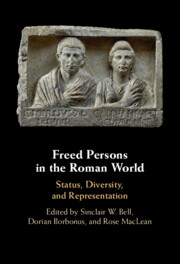Book contents
- Freed Persons in the Roman World
- Freed Persons in the Roman World
- Copyright page
- Contents
- Figures
- Table
- Contributors
- Acknowledgments
- Bibliographical Note
- Introduction
- 1 Permissu decurionum
- 2 Freed Public Slaves in Roman Italy and the Western Provinces
- 3 Fitting in by Decree
- 4 Doubling Up
- 5 The Cost of Ingratitude
- 6 Between Moral Slavery and Legal Freedom
- 7 Framing the Freed Person
- 8 Novel Evidence for Ancient Freed People
- 9 The Affects of Manumission
- General Bibliography
- Index
- References
8 - Novel Evidence for Ancient Freed People
Xenophon of Ephesus’ Ephesiaca and the Cena Trimalchionis
Published online by Cambridge University Press: 16 May 2024
- Freed Persons in the Roman World
- Freed Persons in the Roman World
- Copyright page
- Contents
- Figures
- Table
- Contributors
- Acknowledgments
- Bibliographical Note
- Introduction
- 1 Permissu decurionum
- 2 Freed Public Slaves in Roman Italy and the Western Provinces
- 3 Fitting in by Decree
- 4 Doubling Up
- 5 The Cost of Ingratitude
- 6 Between Moral Slavery and Legal Freedom
- 7 Framing the Freed Person
- 8 Novel Evidence for Ancient Freed People
- 9 The Affects of Manumission
- General Bibliography
- Index
- References
Summary
This chapter compares two fictional texts of the imperial period that represent freed persons, Xenophon of Ephesus’ Ephesiaca and Petronius’ Cena Trimalchionis. The comparison advances our understanding of how Roman freed persons may have come to terms with the experience of slavery. Ephesiaca expresses sympathy for the enslaved elite protagonists Habrocomes and Anthia not only as enslaved elites, but as enslaved persons per se. The novel continues its sympathy for the protagonists after they have been restored to freedom. In particular, the conclusion of Ephesiaca offers a sympathetic depiction of the protagonists’ response to what they had endured in slavery: Habrocomes and Anthia dedicate memorials to their parents, who had died while the protagonists were still enslaved; they withdraw from the wider community and reconstitute a family that includes their fellow freed persons; they spend the rest of their lives in celebration that is shadowed by their recollection of the past and the anticipation of their own mortality. The same motifs, viz., memorialization, recollection of a painful past, seclusion from the wider community, family constituted on the basis of shared experience rather than biology, and melancholic celebration, mark the representation of Trimalchio and his fellow freed persons in the Cena. The parallels suggest the possibility that these motifs typified the representation of the experience of freed persons, sympathetically in Ephesiaca and derisively in the Cena.
Keywords
- Type
- Chapter
- Information
- Freed Persons in the Roman WorldStatus, Diversity, and Representation, pp. 217 - 241Publisher: Cambridge University PressPrint publication year: 2024

